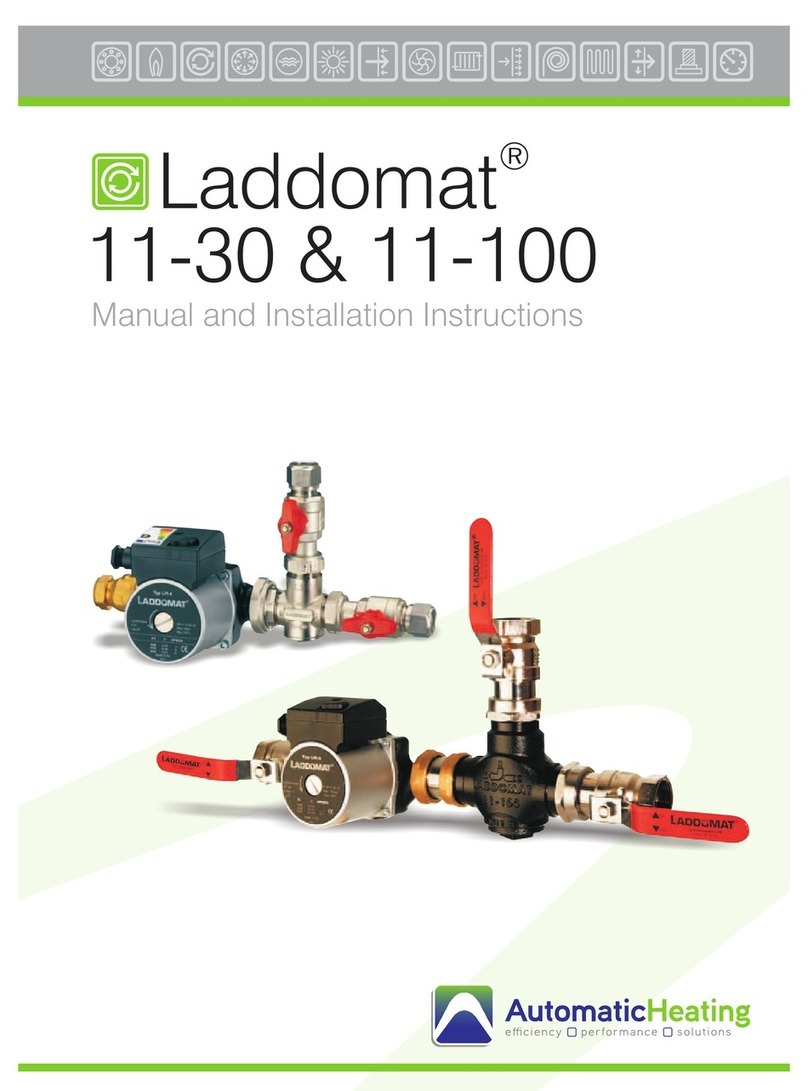3
Starting and stopping the charging
pump
The speed control on the
circulation pump must be in
position 3.
NOTE! Check that the
control is not at the lowest
speed or a neutral position
because this can prevent the
pump from starting.
The pump can be started by
a flue thermostat. If extra
safety is required, a water
thermostat can be connected
in parallel. See image to the
right.
Expansion vessel
The expansion vessel must be sufficiently large, at least
5–10% of the total volume when the tank is open. Opera-
ting pressure must always be at least 2 metre water pillar =
0.2 bar more than the height difference from the pressure
gauge to the upper edge of the highest radiator.
If a pressure vessel is installed, this must be at least 10–20%
of the total volume. Each installation must be specially
dimensioned in accordance with the manufacturer’s
instructions.
Check that the operating pressure, where the installation
is cold, is never lower than the height difference between
the pressure gauge and the highest radiator + 2 metre water
pillar (mwp).
Radiator system
To make the maximum use of the storage tank, it is very
important that the radiator system is fitted with:
1. Automatic by-pass control with flow sensor and room
sensor is ideal for this purpose, thanks to its ability to sense
the heating needs of the house rapidly. The autmatic by-
pass control always matches heat output exactly to
requirements.
2. Thermostatic valves with integrated pressure reduction
devices, which are set to suit the radiator size.
Both measures are intended to reduce the flow and so
reduce the return temperature, without raising the delivery
temperature. The lower the return temperature, the longer
the heat in the tank lasts.
Dimensioning
Generous pipe dimensions and short lengths guarantee
operating reliability, even when the demand for heat is
high. This also allows effective self-circulation in the event
of power failure.
Recommended pipe dimensions at a maximum boiler to
tank distance of 2 m. Total length would then be 2 + 2 m
+ 6 bends. 1 bend is equivalent to 1 m pipe length.
Table 1:
Boiler with max output* up to:
80 kW min. 35 Cu pipe or R32
100 kW min. 42 Cu pipe or R40
120 kW min. 54 Cu pipe or R50
Flow:
At the above pipe dimensions, Laddomat 21-60 gives
2 – 3 m³/h. See flow diagram below.
The dimensions must be increased for longer distances.
The maximum distance between boiler and tank is 6 m.
Total length would then be 6 + 6 m + 6 bends.
If there are special requirements for self-circulation, the
pipes must be dimensioned accordingly.
*Boiler output:
There is a difference between the nominal output and the
maximum output of a boiler. The maximum output can
be as much as 30-50% higher than the boiler’s nominal
output.
Example: If the boiler’s nominal output is 40 kW, the max
output can reach up to 60 kW.
This is very important to include in the calculation when
dimensioning the system.
Connection
Laddomat 21-60 must always be connected in the upright
position as shown in the diagrams.
Place Laddomat 21-60 near the boiler and at the level of
the boiler’s bottom output.
Pipe-runs must be as short as possible and have the
minimum number of bends. Make sure that all air pockets
are eliminated.
The diameter of the pipe from the top of the boiler to
the T-pipe and down to the Laddomat 21-60 must be as
large as possible. This gives low water-velocity, and allows
air released in the boiler to separate out in the expansion
chamber or the vent.























